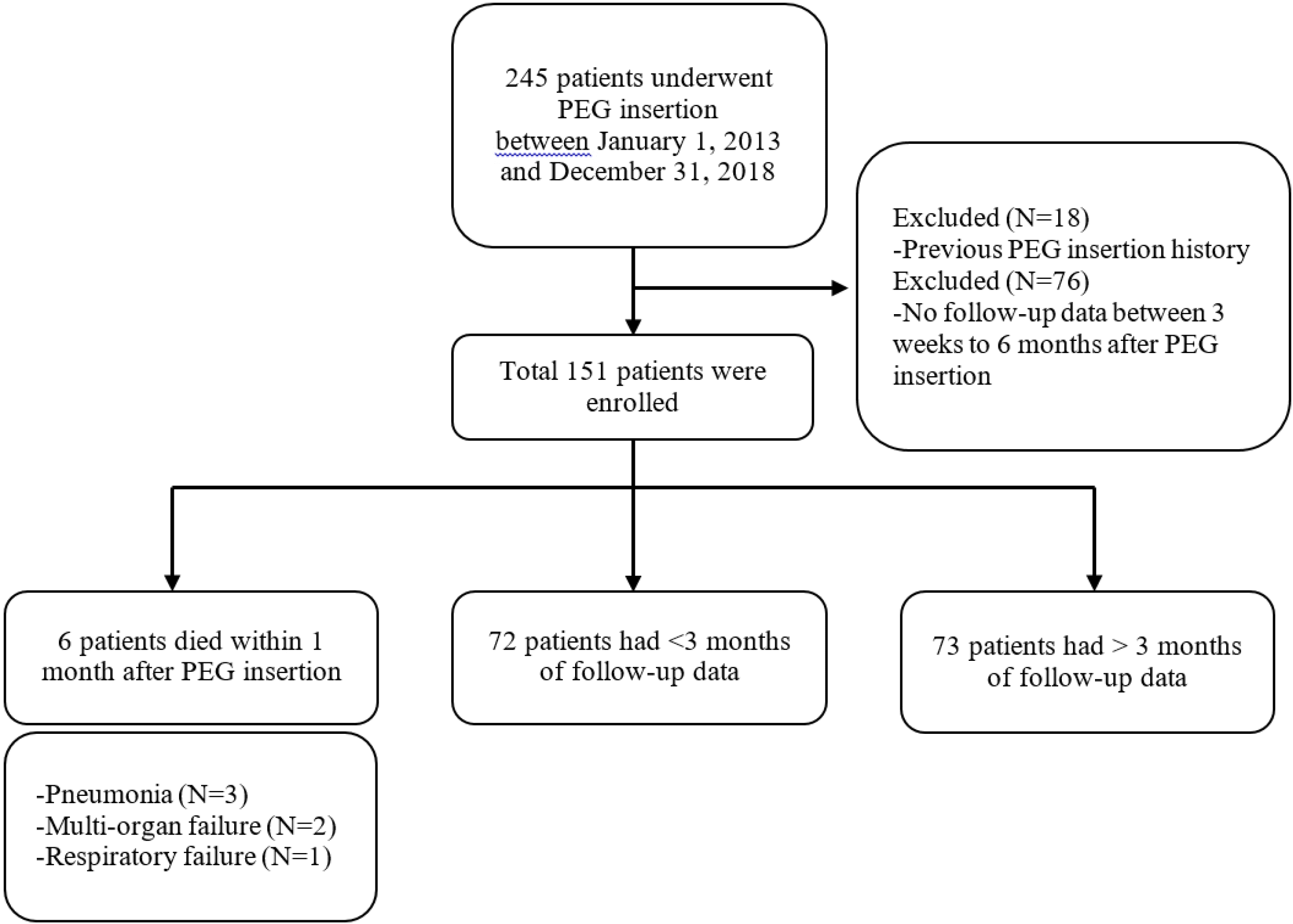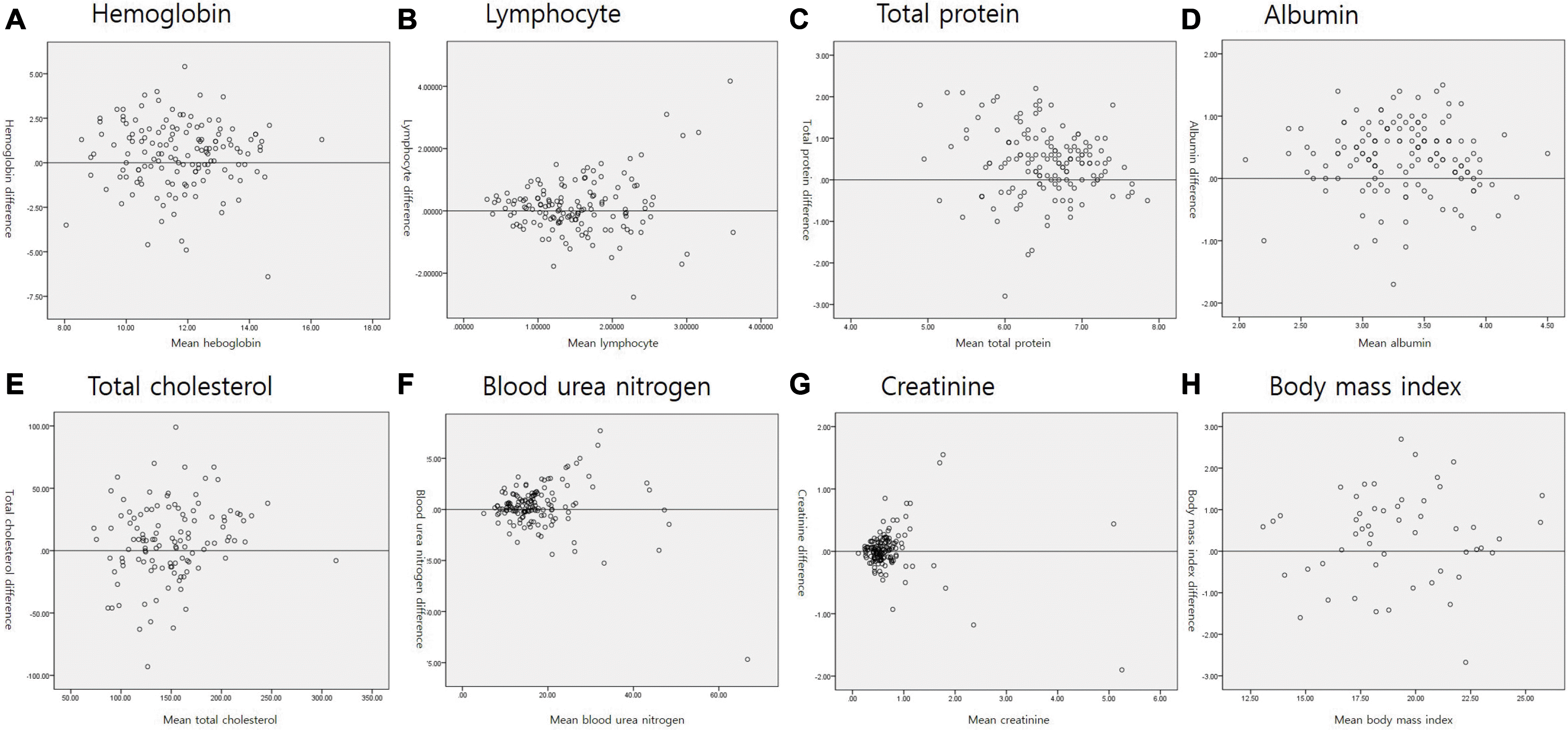2. Baeten C, Hoefnagels J. 1992; Feeding via nasogastric tube or percutaneous endoscopic gastrostomy. A comparison. Scand J Gastroenterol Suppl. 194:95–98. DOI:
10.3109/00365529209096035. PMID:
1298056.

4. Sim JS, Kim SY, Lee YJ, et al. 2017; Indication and clinical outcomes of percutaneous endoscopic gastrostomy: a single-center retrospective analysis. Korean J Helicobacter Up Gastrointest Res. 17:138–143. DOI:
10.7704/kjhugr.2017.17.3.138.

5. Masaki S, Kawamoto T. 2019; Comparison of long-term outcomes between enteral nutrition via gastrostomy and total parenteral nutrition in older persons with dysphagia: a propensity-matched cohort study. PLoS One. 14:e0217120. DOI:
10.1371/journal.pone.0217120. PMID:
31577813. PMCID:
PMC6774498.

6. Meier R. 2009; Basics in clinical nutrition: endoscopic access (PEG and PEJ). E Spen Eur E J Clin Nutr Metab. 5:e216–e218. DOI:
10.1016/j.eclnm.2009.05.010.

7. Gauderer MW, Ponsky JL, Izant RJ Jr. 1980; Gastrostomy without laparotomy: a percutaneous endoscopic technique. J Pediatr Surg. 15:872–875. DOI:
10.1016/S0022-3468(80)80296-X. PMID:
6780678.

8. Deitel M, Bendago M, Spratt EH, Burul CJ, To TB. 1988; Percutaneous endoscopic gastrostomy by the "pull" and "introducer" methods. Can J Surg. 31:102–104. PMID:
3349370.
9. Gauderer MW. 2001; Percutaneous endoscopic gastrostomy-20 years later: a historical perspective. J Pediatr Surg. 36:217–219. DOI:
10.1053/jpsu.2001.20058. PMID:
11150469.

10. Nunes G, Santos CA, Santos C, Fonseca J. 2016; Percutaneous endoscopic gastrostomy for nutritional support in dementia patients. Aging Clin Exp Res. 28:983–989. DOI:
10.1007/s40520-015-0485-2. PMID:
26582081.

11. Park RH, Allison MC, Lang J, et al. 1992; Randomised comparison of percutaneous endoscopic gastrostomy and nasogastric tube feeding in patients with persisting neurological dysphagia. BMJ. 304:1406–1409. DOI:
10.1136/bmj.304.6839.1406. PMID:
1628013. PMCID:
PMC1882203.

12. Silander E, Nyman J, Bove M, Johansson L, Larsson S, Hammerlid E. 2012; Impact of prophylactic percutaneous endoscopic gastrostomy on malnutrition and quality of life in patients with head and neck cancer: a randomized study. Head Neck. 34:1–9. DOI:
10.1002/hed.21700. PMID:
21374756.

13. Löser C, Aschl G, Hébuterne X, et al. 2005; ESPEN guidelines on artificial enteral nutrition--percutaneous endoscopic gastrostomy (PEG). Clin Nutr. 24:848–861. DOI:
10.1016/j.clnu.2005.06.013. PMID:
16261664.
14. Fortunato JE, Troy AL, Cuffari C, et al. 2010; Outcome after percutaneous endoscopic gastrostomy in children and young adults. J Pediatr Gastroenterol Nutr. 50:390–393. DOI:
10.1097/MPG.0b013e3181aed6f1. PMID:
20179645.

15. Rondanelli M, Talluri J, Peroni G, et al. 2018; Beyond body mass index. Is the Body Cell Mass Index (BCMI) a useful prognostic factor to describe nutritional, inflammation and muscle mass status in hospitalized elderly?: Body Cell Mass Index links in elderly. Clin Nutr. 37:934–939. DOI:
10.1016/j.clnu.2017.03.021. PMID:
28408051.

16. Trevisan C, Crippa A, Ek S, et al. 2019; Nutritional status, body mass index, and the risk of falls in community-dwelling older adults: a systematic review and meta-analysis. J Am Med Dir Assoc. 20:569–582.e7. DOI:
10.1016/j.jamda.2018.10.027. PMID:
30554987.

17. Perna S, Guido D, Grassi M, Rondanelli M. 2015; Association between muscle mass and adipo-metabolic profile: a cross-sectional study in older subjects. Clin Interv Aging. 10:499–504. DOI:
10.2147/CIA.S67872. PMID:
25759569. PMCID:
PMC4345994.
18. Araújo JP, Friões F, Azevedo A, et al. 2008; Cholesterol--a marker of nutritional status in mild to moderate heart failure. Int J Cardiol. 129:65–68. DOI:
10.1016/j.ijcard.2007.05.026. PMID:
17643521.

19. Xu SS, Li S, Xu HX, et al. 2020; Haemoglobin, albumin, lymphocyte and platelet predicts postoperative survival in pancreatic cancer. World J Gastroenterol. 26:828–838. DOI:
10.3748/wjg.v26.i8.828. PMID:
32148380. PMCID:
PMC7052532.

20. O'Daly BJ, Walsh JC, Quinlan JF, et al. 2010; Serum albumin and total lymphocyte count as predictors of outcome in hip fractures. Clin Nutr. 29:89–93. DOI:
10.1016/j.clnu.2009.07.007. PMID:
19674819.
21. Fletcher JP, Little JM, Guest PK. 1987; A comparison of serum transferrin and serum prealbumin as nutritional parameters. JPEN J Parenter Enteral Nutr. 11:144–147. DOI:
10.1177/0148607187011002144. PMID:
3108533.

22. Beck FK, Rosenthal TC. 2002; Prealbumin: a marker for nutritional evaluation. Am Fam Physician. 65:1575–1578. PMID:
11989633.
23. Sjoquist KM, Renfro LA, Simes RJ, et al. 2018; Personalizing survival predictions in advanced colorectal cancer: the ARCAD nomogram project. J Natl Cancer Inst. 110:638–648. DOI:
10.1093/jnci/djx253. PMID:
29267900. PMCID:
PMC6005015.

24. de Almeida JP, Vincent JL, Galas FR, et al. 2015; Transfusion requirements in surgical oncology patients: a prospective, randomized controlled trial. Anesthesiology. 122:29–38. DOI:
10.1097/ALN.0000000000000511. PMID:
25401417.
25. hindi B, Hermanns T, Wei Y, et al. 2016; Identification of the best complete blood count-based predictors for bladder cancer outcomes in patients undergoing radical cystectomy. Br J Cancer. 114:207–212. DOI:
10.1038/bjc.2015.432. PMID:
26657651. PMCID:
PMC4815810.

26. McGrane JM, Humes DJ, Acheson AG, Minear F, Wheeler JMD, Walter CJ. 2017; Significance of anemia in outcomes after neoadjuvant chemoradiotherapy for locally advanced rectal cancer. Clin Colorectal Cancer. 16:381–385. DOI:
10.1016/j.clcc.2017.03.016. PMID:
28456481.

27. Thongprayoon C, Cheungpasitporn W, Chewcharat A, Mao MA, Thirunavukkarasu S, Kashani KB. 2020; Risk of acute respiratory failure among hospitalized patients with various admission serum albumin levels: a cohort study. Medicine (Baltimore). 99:e19352. DOI:
10.1097/MD.0000000000019352. PMID:
32118775. PMCID:
PMC7478795.
28. Sergi G, Coin A, Enzi G, et al. 2006; Role of visceral proteins in detecting malnutrition in the elderly. Eur J Clin Nutr. 60:203–209. DOI:
10.1038/sj.ejcn.1602289. PMID:
16234837.

29. Vlassopoulos A, Combet E, Lean ME. 2014; Changing distributions of body size and adiposity with age. Int J Obes (Lond). 38:857–864. DOI:
10.1038/ijo.2013.216. PMID:
24247373.

30. Budzyński J, Tojek K, Wustrau B, et al. 2018; The "cholesterol paradox" among inpatients - retrospective analysis of medical documentation. Arch Med Sci Atheroscler Dis. 3:e46–e57. DOI:
10.5114/amsad.2018.74736. PMID:
30775589. PMCID:
PMC6374572.

31. Reddy VS, Bui QT, Jacobs JR, et al. 2015; Relationship between serum low-density lipoprotein cholesterol and in-hospital mortality following acute myocardial infarction (the lipid paradox). Am J Cardiol. 115:557–562. DOI:
10.1016/j.amjcard.2014.12.006. PMID:
25727079.

32. Kuzuya M, Kanda S, Koike T, Suzuki Y, Iguchi A. 2005; Lack of correlation between total lymphocyte count and nutritional status in the elderly. Clin Nutr. 24:427–432. DOI:
10.1016/j.clnu.2005.01.003. PMID:
15896430.

33. Rahnemai-Azar AA, Rahnemaiazar AA, Naghshizadian R, Kurtz A, Farkas DT. 2014; Percutaneous endoscopic gastrostomy: indications, technique, complications and management. World J Gastroenterol. 20:7739–7751. DOI:
10.3748/wjg.v20.i24.7739. PMID:
24976711. PMCID:
PMC4069302.

34. Pih GY, Na HK, Ahn JY, et al. 2018; Risk factors for complications and mortality of percutaneous endoscopic gastrostomy insertion. BMC Gastroenterol. 18:101. DOI:
10.1186/s12876-018-0825-8. PMID:
29954339. PMCID:
PMC6025834.

35. Kähler G, Götz M, Senninger N. 2016. Therapeutic endoscopy in the Gastrointestinal Tract. 1st ed. Springer;New York:







 PDF
PDF Citation
Citation Print
Print



 XML Download
XML Download